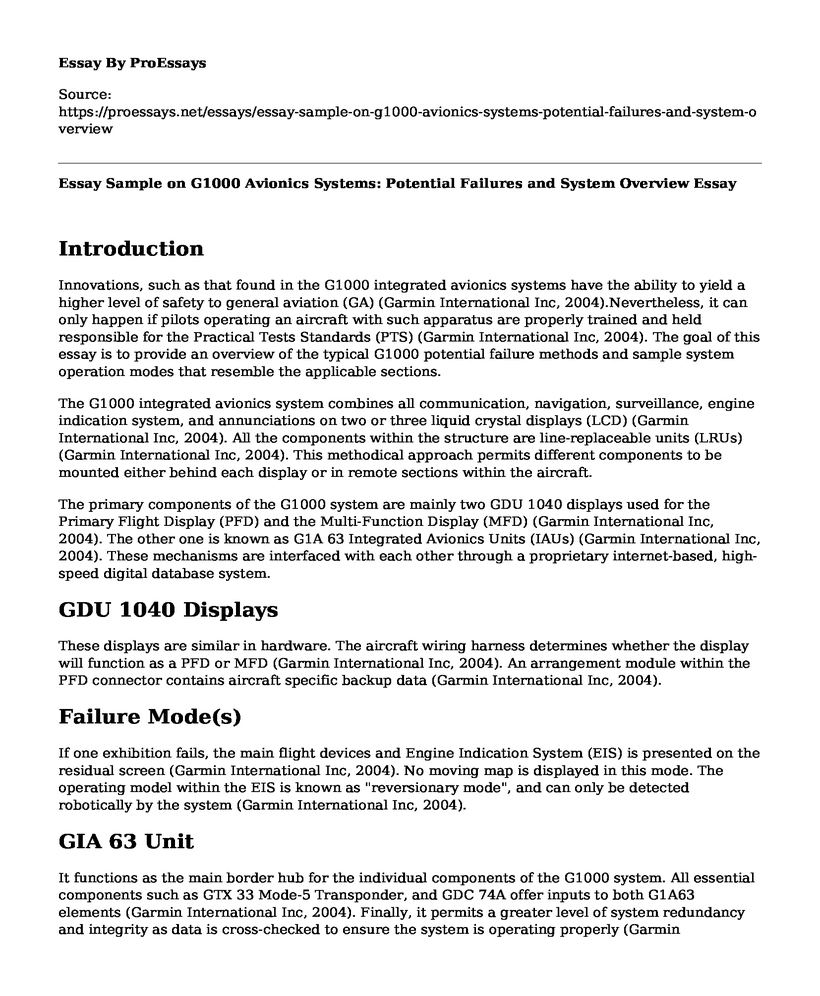Introduction
Innovations, such as that found in the G1000 integrated avionics systems have the ability to yield a higher level of safety to general aviation (GA) (Garmin International Inc, 2004).Nevertheless, it can only happen if pilots operating an aircraft with such apparatus are properly trained and held responsible for the Practical Tests Standards (PTS) (Garmin International Inc, 2004). The goal of this essay is to provide an overview of the typical G1000 potential failure methods and sample system operation modes that resemble the applicable sections.
The G1000 integrated avionics system combines all communication, navigation, surveillance, engine indication system, and annunciations on two or three liquid crystal displays (LCD) (Garmin International Inc, 2004). All the components within the structure are line-replaceable units (LRUs) (Garmin International Inc, 2004). This methodical approach permits different components to be mounted either behind each display or in remote sections within the aircraft.
The primary components of the G1000 system are mainly two GDU 1040 displays used for the Primary Flight Display (PFD) and the Multi-Function Display (MFD) (Garmin International Inc, 2004). The other one is known as G1A 63 Integrated Avionics Units (IAUs) (Garmin International Inc, 2004). These mechanisms are interfaced with each other through a proprietary internet-based, high-speed digital database system.
GDU 1040 Displays
These displays are similar in hardware. The aircraft wiring harness determines whether the display will function as a PFD or MFD (Garmin International Inc, 2004). An arrangement module within the PFD connector contains aircraft specific backup data (Garmin International Inc, 2004).
Failure Mode(s)
If one exhibition fails, the main flight devices and Engine Indication System (EIS) is presented on the residual screen (Garmin International Inc, 2004). No moving map is displayed in this mode. The operating model within the EIS is known as "reversionary mode", and can only be detected robotically by the system (Garmin International Inc, 2004).
GIA 63 Unit
It functions as the main border hub for the individual components of the G1000 system. All essential components such as GTX 33 Mode-5 Transponder, and GDC 74A offer inputs to both G1A63 elements (Garmin International Inc, 2004). Finally, it permits a greater level of system redundancy and integrity as data is cross-checked to ensure the system is operating properly (Garmin International Inc, 2004).
Conclusion
In conclusion, the paper has provided a summary of the typical G1000 probable failure methods and sample system operation modes that resemble the applicable sections. The main function of the G1000 integrated avionics system is to merge all communication, navigation, surveillance, and engine indication system. Finally, the operating model within the EIS is known as "reversionary mode".
References
Garmin International Inc. (2004). G1000: Guide for Designated Pilot Examiners and Certified Flight Instructors. Retrieved from: https://www.faa.gov/training_testing/training/fits/guidance/media/g1000.pdf
Cite this page
Essay Sample on G1000 Avionics Systems: Potential Failures and System Overview. (2023, Mar 04). Retrieved from https://proessays.net/essays/essay-sample-on-g1000-avionics-systems-potential-failures-and-system-overview
If you are the original author of this essay and no longer wish to have it published on the ProEssays website, please click below to request its removal:
- How AI Is Being Used as a Source of Innovation in Firms? - Paper Example
- Nuclear Energy as the Best Source to Produce Energy Essay Example
- Paper Example on Interconnected World: Exploring the Impact of IoT
- Essay on Microsoft: Innovative Strategies for Software Progress & Consumer Satisfaction
- Essay Example on Amazon Fire Stick: Enhancing User Experience with Internet of Things
- Research Paper Sample on Protecting Privacy on Social Network Platforms: Strategies
- Border Officials Can Search Your Phone - Essay Sample







